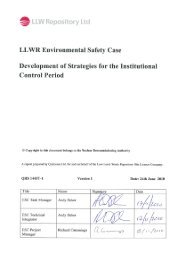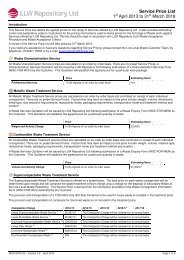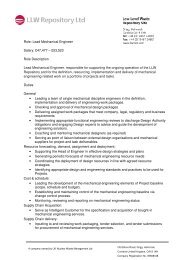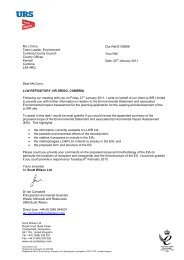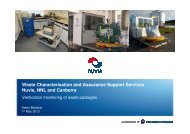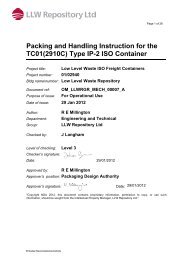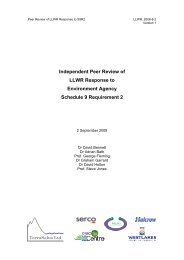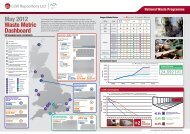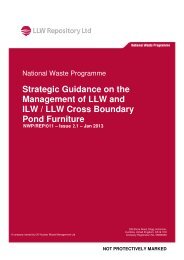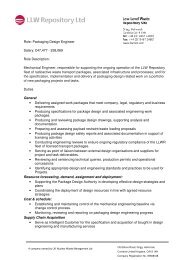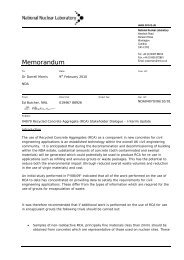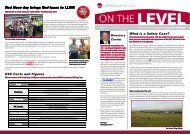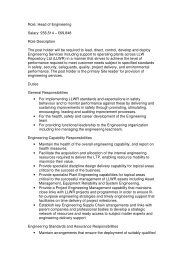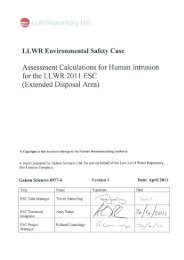LA LLW Capacity Assessment â March 2013 - Low Level Waste ...
LA LLW Capacity Assessment â March 2013 - Low Level Waste ...
LA LLW Capacity Assessment â March 2013 - Low Level Waste ...
You also want an ePaper? Increase the reach of your titles
YUMPU automatically turns print PDFs into web optimized ePapers that Google loves.
<strong>LLW</strong> Repository LtdNational <strong>Waste</strong> ProgrammeNWP/REP/012Issue 3 – <strong>March</strong> <strong>2013</strong>Page 23 of 247. ConclusionsThis report has undertaken a high level comparison of those waste material volumes thatcould be sent for alternative disposal at permitted landfill facilities with the availablecapacity of those sites.Three waste inventory data-sets were considered: 2010 UKRWI for the period 2012 – 2030; 2012 JWMPs from Sellafield, Magnox and RSRL for the 5 year periodcommencing April 2012; 2012 WIF for the period 2012 – 2030.Three authorised landfill facilities were included: FCC’s Lillyhall site; Augean’s ENRMF site; SITA’s Clifton Marsh site.The available capacity headroom was assessed for the period 2012 – 2030 on both anational and regional basis.The key conclusions for the national assessment were: There is adequate capacity in the existing permitted sites until December 2016. If extensions to planning consents are obtained for the sites (including the abilityfor FCC to accept <strong>LA</strong>-<strong>LLW</strong>), there is adequate capacity until 2030.The conclusions from the regional analysis were: There is adequate capacity in the Southern region until December 2016 with thecurrent permits; or until 2026 if ENRMF gain an extension to their planningconsent. After 2026 more capacity would need to be identified and permissioned ifdisposal solutions were still required and demonstrated as BAT; or after 2016 if theextended permissions were not granted. In the Northern region, with the current planning consents, there is adequatecapacity until December 2015. If extensions to planning consents are obtained forthe existing sites, there would be adequate capacity until 2020, or potentially laterif radiological or volumetric capacity was still remaining at Clifton Marsh. If FCCLillyhall gain consent to accept <strong>LA</strong>-<strong>LLW</strong>, combined with an extension to 2031,there would be adequate capacity until 2030 in the North of the UK. If the extendedconsents were not granted, more capacity would need to be identified andpermissioned after December 2015.Because the actual categorisation of the waste only occurs when it arises (for example,waste that was predicted to be <strong>LA</strong>-<strong>LLW</strong> could be exempt, or waste that was predicted tobe <strong>LLW</strong> could be <strong>LA</strong>-<strong>LLW</strong>) and because the consigning sites will need to make aBAT/BPEO case for the wastes, flexibility and a degree of spare capacity in waste routesis valuable to support application of the waste hierarchy and to preserve repositorycapacity.A company owned by UK Nuclear <strong>Waste</strong> Management LtdOld Shore Road, Drigg, Holmrook,Cumbria, United Kingdom, CA19 1XHCompany Registration No. 05608448The potential use of <strong>LA</strong>-<strong>LLW</strong> in the <strong>LLW</strong>R cap could provide an opportunity for materialre-use, and therefore reduce the volumes that would be required to be disposed of insuitable landfill sites. This is the subject of ongoing technical assessment; and wouldrequire a business case to be approved to execute the project.NOT PROTECTIVELY MARKED



